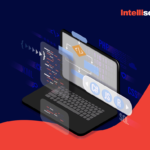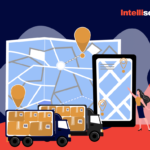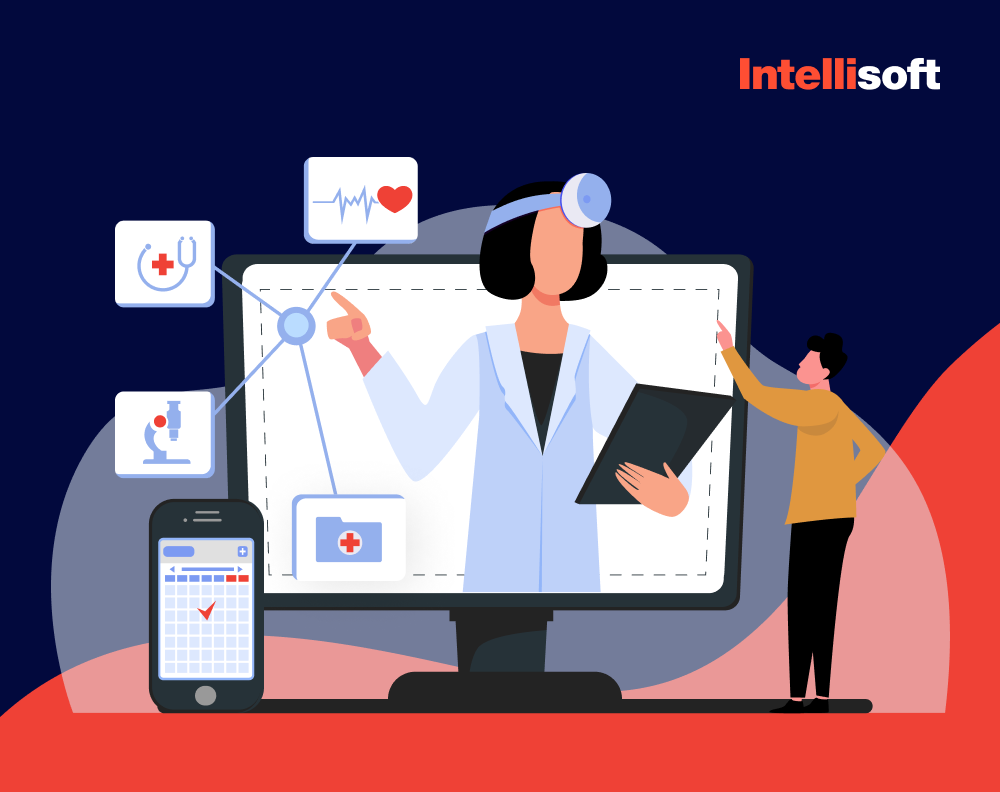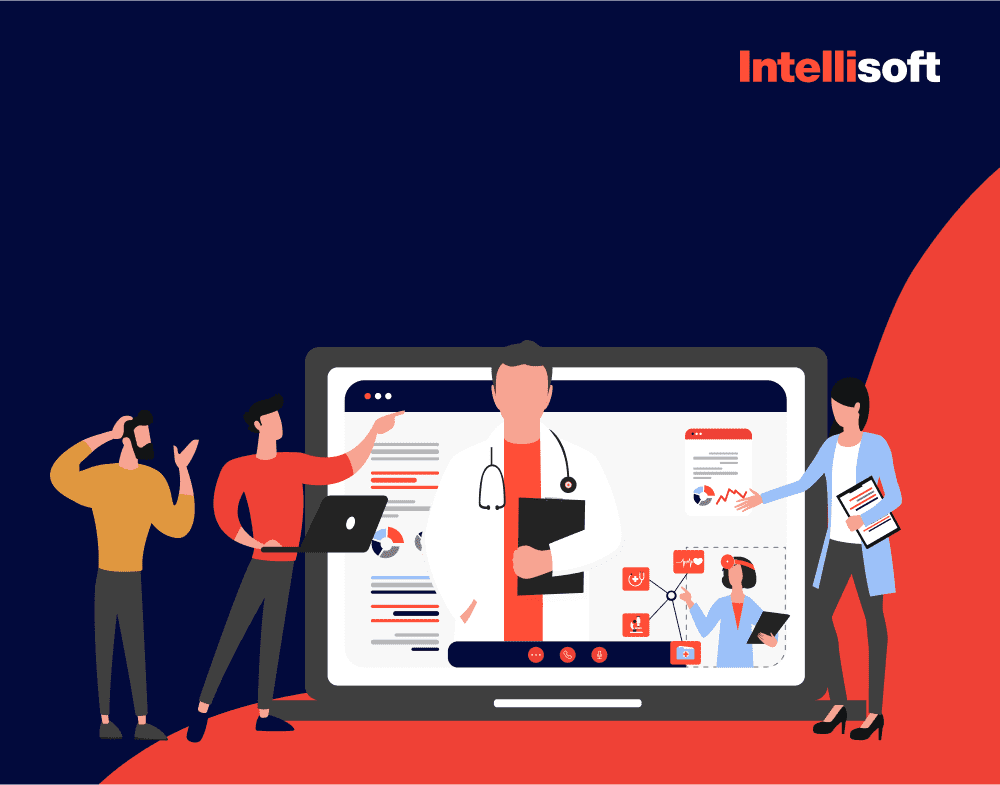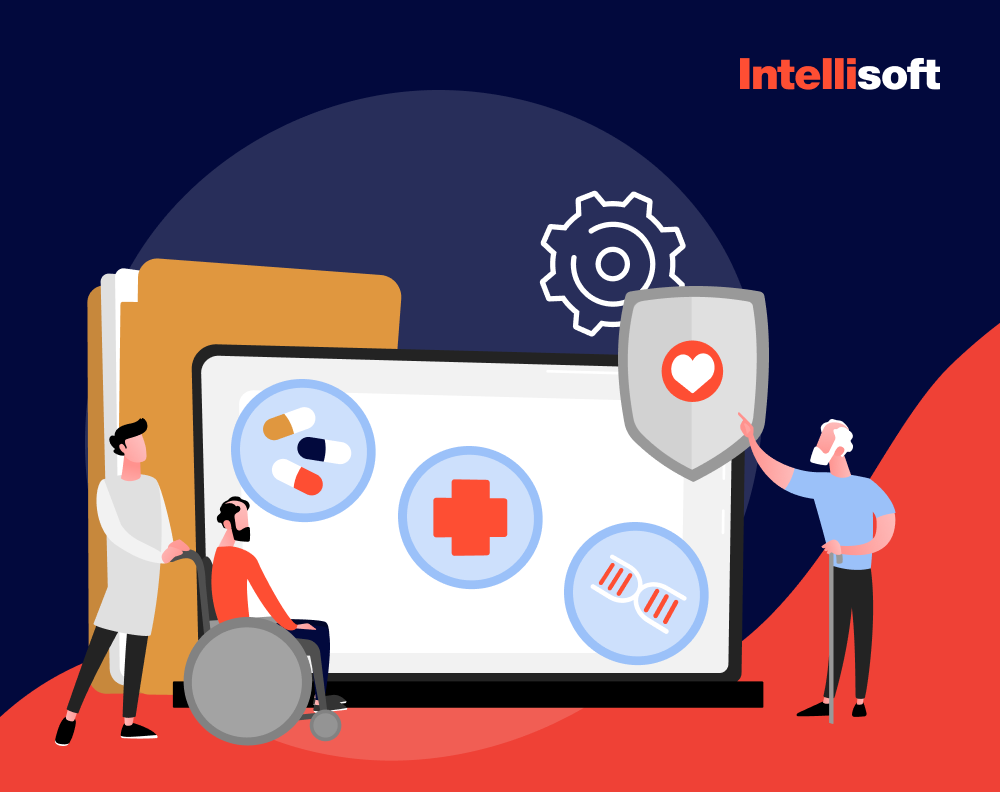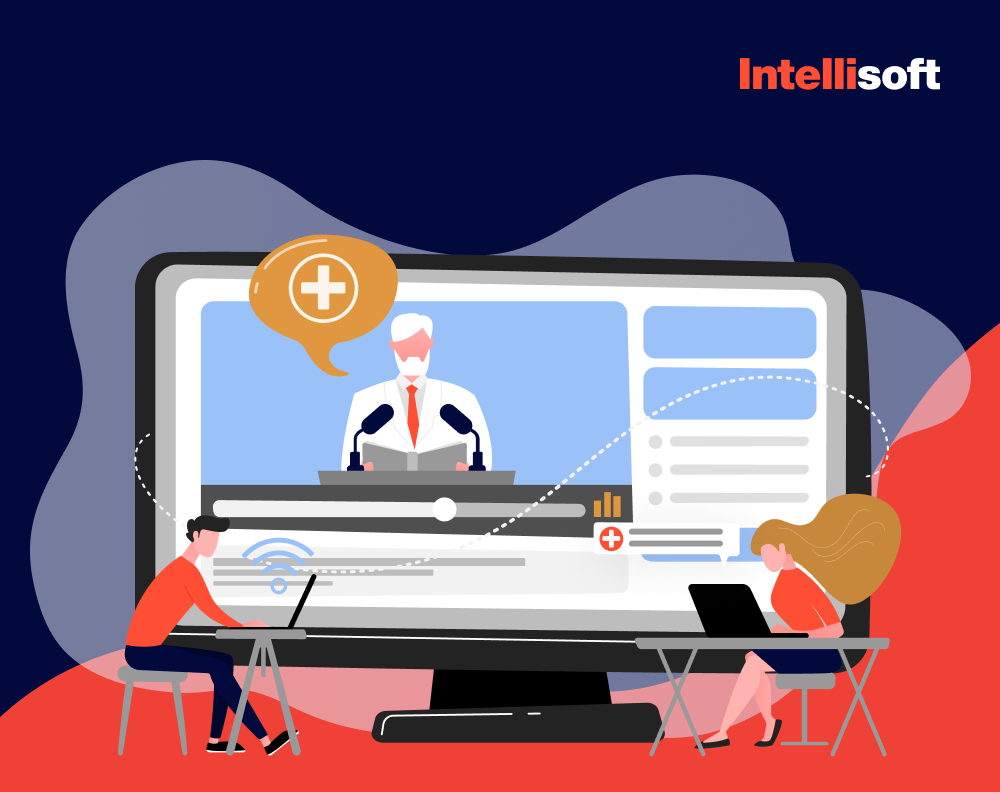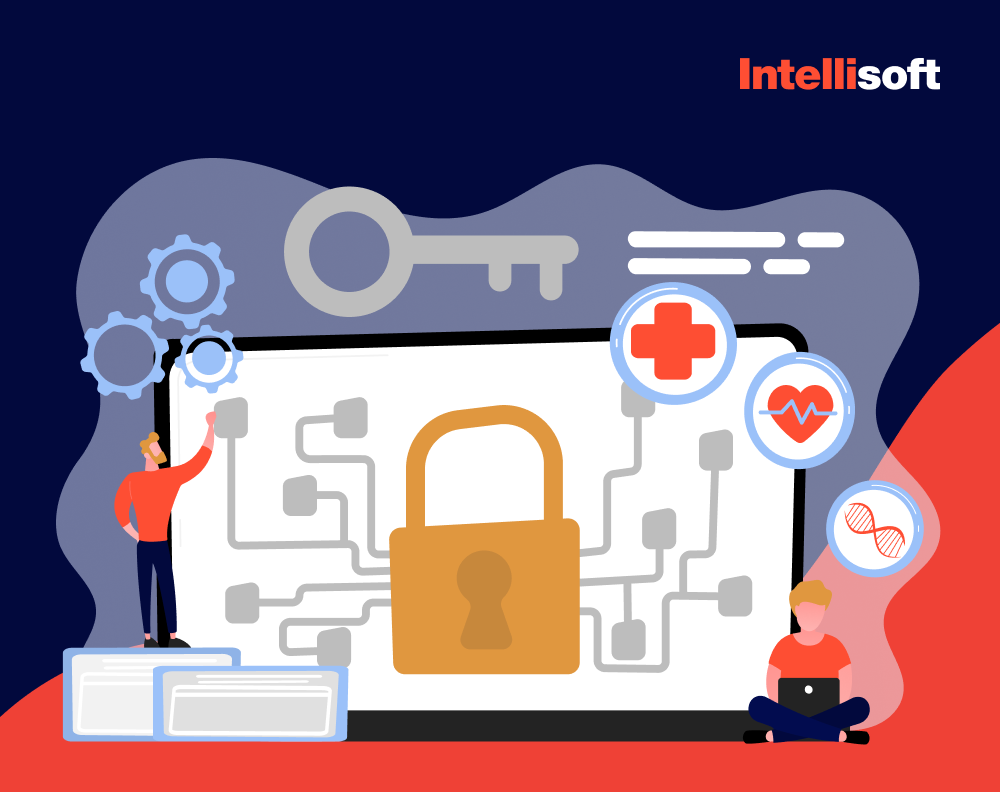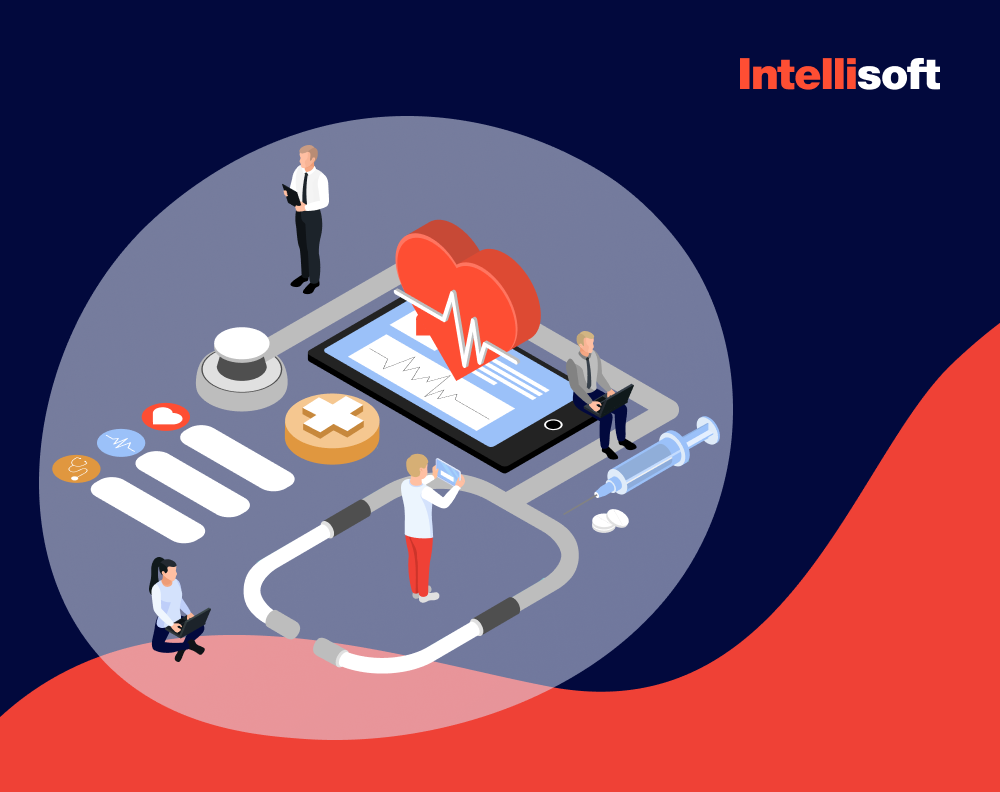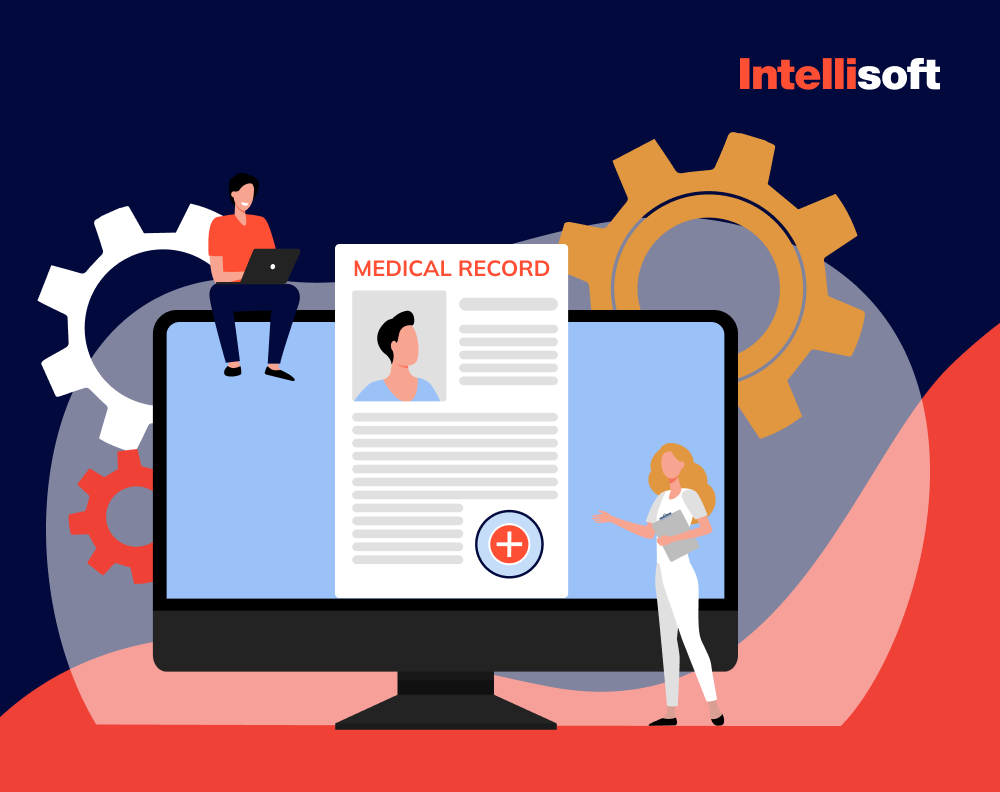The pandemic has made online doctor appointment apps highly popular, making doctor appointment app development more sought-after than ever before. These tools offer useful features such as remote consultations, support for multiple languages, and even the ability to link with your insurance. These changes have opened up new opportunities for businesses and tech enthusiasts. This is why doctor appointment apps have become the Netflix of healthcare – everyone’s subscribed, and the content (or, in this case, the convenience) is king.
Surprisingly, more than 80% of people using healthcare appointment applications started doing so only during the pandemic. What’s even more surprising is that this trend is continuing. Even after the pandemic, 43% of adults still use online booking systems.
If you’re considering diving into doctor appointment application development, you’re on the right track. At Intellisoft, we have extensive experience in healthcare software development, from custom solutions to existing software integration. We’ll share key features to build such a product, the development process, and dev team composition to guide you in creating a successful doctor appointment booking system.
Table of Contents
Appointment App Statistics
The global market for online doctor consultations is expected to grow at a CAGR of 10.01% and reach a valuation of $35.41 billion by 2027. For reference, the market is estimated to be worth $21.9 billion in 2022.
There are also some more interesting figures showcasing the tremendous potential of an app for doctor appointment. According to data from Zippia, around 34% of online appointment bookings are made outside of regular office hours. Interestingly, clients schedule 46% of appointments online, while staff members manage the remaining 54%. Notably, a significant number of appointments, around 40%, are booked beyond typical business hours.
The industry has seen a significant shift with the integration of artificial intelligence in scheduling processes and a surge of online booking systems. These advancements simplify appointment management and provide personalized customer interactions and data analysis opportunities. Besides, the rise of mobile applications and web-based platforms has made scheduling more accessible and user-friendly, catering to modern consumers’ convenience.
Another tech trend is automated reminders that have played a vital role in reducing no-shows, with a substantial 29% decrease observed. This data highlights the positive impact of technological interventions in appointment management. Besides, the data shows that Sundays from 4:00 to 8:00 p.m. are the most popular day and time for scheduling engagements in any doctor on demand app.
The introduction of self-scheduling has also led to a remarkable 17% reduction in no-show occurrences, emphasizing the effectiveness of empowering individuals to manage their appointments.
What Are the Key Features of a Doctor Appointment Mobile App?
Creating a doctors on demand app for Android or iOS involves several key features to ensure it is efficient, user-friendly, and secure. Each feature plays a crucial role in enhancing the overall experience for both patients and healthcare providers. Here’s a detailed look at the core functionalities:
User Registration and Profile Management
This feature enables users to sign up and create profiles to manage their personal information, health records, and appointment history efficiently.
Doctor Profiles and Reviews
Offers detailed profiles for doctors, showcasing their qualifications, specialties, years of experience, and patient reviews, aiding users in making informed decisions.
Appointment Scheduling
This functionality allows users to view doctor availability and book appointments directly through the app, with options for rescheduling and cancellations.
Search Functionality
A comprehensive search feature enables users to find doctors by name, specialty, location, and availability, with added filters and sorting options to enhance the search experience.
Integration with Calendars
The app for doctor appointment can integrate with the user’s calendar, facilitating reminders and scheduling convenience
Notifications and Reminders
Users can get push notifications or SMS reminders for upcoming appointments, vaccinations, and health check-ups to minimize missed appointments.
Telehealth Features
This includes video consultations for patients preferring virtual visits or those unable to travel, featuring secure video calling and messaging capabilities.
Prescription Management
Doctors can send e-prescriptions directly to patients or pharmacies, simplifying the process of managing medication schedules and refills.
Payment Gateway Integration
A doctor appointment booking app includes secure payment options for consultations, treatments, and other services, ensuring a seamless transaction process.
Health Records Access
Patients can access their medical records, lab results, and prescription history through a secure and user-friendly interface.
Privacy and Security
The app adheres to health information privacy regulations (such as HIPAA in the U.S.) to protect patient data, with strong encryption and authentication measures in place.
Help and Support
A dedicated help section or live support is available for users needing assistance with the app for doctor appointment or have inquiries about their health services.
Feedback System
Users can provide feedback on their experiences with doctors and the app to continuously improve service quality.

Roadmap for Doctor Appointment Software Development
At IntelliSoft, we typically follow a series of steps to develop a doctor on demand app.
Discovery and planning
This stage typically takes around 2-4 weeks and involves the following activities:
- Analyzing the business goals for the appointment app, competing applications, and target user needs.
- Gathering the app’s functional and non-functional requirements in a single document.
- Defining applicable compliance requirements (such as HIPAA, HITECH, FDA, NCPDP, and GDPR) and creating a roadmap to compliance.
- Planning the collection and processing of protected health information (PHI) in detail, including creating a roles and permissions matrix, determining data archival and clearing mechanisms, and establishing a data retention period.
- Creating a detailed software requirements specification.
- Outlining the project scope and delivery schedule and determining the doctor appointment app development company and budget.
- Analyzing project risks, PHI breach risks, and developing a risk mitigation plan.
- Creating the on demand doctor appointment app development roadmap and a business case.
We prioritize a thorough discovery phase to identify these requirements, tailoring the doctor appointment booking app development process to create a robust and secure foundation for your app’s success.
Design
During this stage, which takes 2–4 weeks, we complete the following tasks:
- Research to gather information for UX design.
- Creating maps of patient and doctor journeys, developing wireframes, and building dynamic prototypes.
- Designing visually appealing and accessible user interfaces and presenting UI mockups.
- Developing the app’s architecture for specific platforms such as iOS, Android, cross-platform, web, and desktop.
- Selecting appropriate technologies and frameworks.
- Planning for integration with external systems and applications, such as practice management software and payment gateways.
Development
This stage is the most time-consuming, as it takes 2–8+ months, depending on the solution’s complexity. During this step, IntelliSoft, as the doctor appointment mobile app development company, takes the following steps:
- Building the user and server sides of the dr on demand app in 2-4 week sprints.
- Role-specific UI elements will be developed, such as a doctor’s dashboard, which will display patient profiles, appointment schedules, medical history, and prescription options.
- Implementing security features, including PHI encryption in transit and at rest and multi-factor authentication.
- Establishing PHI backup mechanisms and PHI breach detection and notification processes.
- HL7 integration with healthcare systems, such as EHR/EMR, LIS, and PACS, will be performed to connect the app with other medical software.
Testing
This stage takes around 30% of the project time, depending on the complexity of the doctor appointment application development, security and compliance requirements, and level of test automation. It runs in parallel with stage 3 and covers:
- Running tests concurrently with doctor appointment booking app development to address functional and non-functional requirements.
- Identifying and rectifying any issues within the application.
- Ensuring the app meets PHI security, usability, accessibility, and compliance standards (for example, HIPAA, HITECH, GDPR, and others).
- Performing integration testing to ensure secure data flow between connected solutions and carrying out compatibility testing to ensure the proper functioning of the app across various environments.
- Verifying the app’s ability to manage large data volumes and high user load effectively.
Deployment and release
This critical phase spans 1 to 3 weeks and encompasses the final steps before the doctor appointment app becomes operational within a healthcare organization’s IT framework. Key activities include:
- Performing thorough assessments to ensure the application’s alignment with regulatory standards (including conducting a HIPAA risk assessment or a GDPR compliance audit).
- Setting up the application’s infrastructure, including meticulous planning and implementation of backup and recovery procedures to prevent data loss and ensure continuity of care.
- Strengthening the infrastructure’s security to protect sensitive health information against unauthorized access, breaches, and other cyber threats.
- Integrating the application into the healthcare organization’s IT environment ensures that it is fully functional and ready for use by healthcare providers and patients.
Maintenance and evolution
This ongoing phase ensures the application remains relevant, secure, and compliant, adapting over time to meet the evolving needs of users and the healthcare industry. Activities encompass:
- Incorporating new features for doctors and patients based on user feedback and evolving expectations.
- Improving the non-functional features of the app.
- Updating the app for doctor appointment regularly to fix the bugs and keep the app highly secured.
- Ensuring that the appointment app meets the required standards and undergoes compliance audits.

Related Articles:
- What is EHR Software? Build Your Custom System and Digitize Doctor’s Scribbles with IntelliSoft
- Automation in the Industry of Healthcare: Main Benefits for Business
- Hospital App Development: Innovate, Integrate, and Provide Better Care
- Healthcare App Development Guide: Transforming Patient Care with User-Centric Solutions
- A Step-by-Step Guide to Developing HIPAA-compliant Medical Apps
Typical Project Roles in Doctor Appointment App Development
When developing a custom doctor appointment app, it’s crucial to clearly understand the specific requirements and goals to determine the team composition. IntelliSoft’s experienced consultants have outlined the most common project roles to help you comprehend the responsibilities and skills required for successful project completion.
Project manager
The Project manager creates a strategic development plan, overseeing schedules and resource allocation to ensure efficient application delivery. They manage risks, engage stakeholders, and report on progress and key performance indicators
Healthcare IT consultant
A Healthcare IT consultant collects and documents application requirements, offering guidance on functionalities, architecture, technologies, and integrations. They assess how the application impacts clinical operations and patient experience.
Software architect
The software architect designs a scalable and secure application architecture, choosing a technology stack with robust security protocols for a dr. on demand app. They enforce best coding practices to mitigate risks, ensuring the reliability of patient care delivery.
UX designer
The UX designer conducts user research to develop personas and scenarios, maps user journeys, designs UI prototypes and wireframes, and tests applications for accessibility and usability to optimize user interaction.
UI designer
The UI designer’s role is to create a user-friendly and engaging interface that allows for easy navigation and appointment management.
DevOps engineer
This position entails creating the infrastructure for doctor appointment booking app development, continuous integration/delivery pipelines, containerization, and virtualization. The DevOps engineer also oversees dr on demand app security, performance, and availability and develops data backup and recovery strategies.
Front-end developer
The Front-end developer works on the web-based interfaces for doctor/patient interaction and the administrative panel, addressing UI/UX issues to enhance the user experience.
Back-end developer
Focused on the application’s server side, the back-end developer ensures security and privacy compliance, manages business logic and debugs software.
Mobile developer
The Mobile developer creates a patient mobile application that is both accessible and efficient. This doctor on demand application should be integrated with the primary application’s back-end and pertinent healthcare systems and follow industry standards such as FHIR.
QA engineer
Responsible for developing and implementing detailed testing protocols, the QA engineer verifies the application’s functionality, identifying and documenting any bugs.
Regulatory consultant
The Regulatory consultant continuously evaluates compliance with healthcare regulations such as HIPAA, HITECH, GDPR, and PCI DSS throughout the application lifecycle.
Cybersecurity specialist
The cybersecurity specialist performs regular audits to identify cyber threats and implements security measures like intrusion detection and prevention systems, firewalls, and data encryption to protect the application’s architecture and features.
Technology Stack in Doctor Appointment App Development
When developing a doctor appointment app, selecting a reliable technology stack that can provide excellent performance and scalability is crucial. The technology stack required for building an online doctor scheduling app may differ based on the project’s complexity and the features you want. However, you need the following basic technology stacks to create a healthcare app. Our doctor appointment mobile app development company experts recommend the following solutions:
- Front-end development: ReactJS, Angular
- Back-end development: PHP, Node.js, Phyton; database — Postgres, MongoDB, MySQL
- Payment processing: PayPal, Stripe, Braintree
- Mobile development: Swift for iOS and Java for Android
- Map integration: Google Maps API, CoreLocation, MapKit
- In-app communication: Twilio
- Push notifications: Twilio, Push.io
- Cloud ecosystem: Amazon Web Services (AWS), Google, Microsoft Azure.
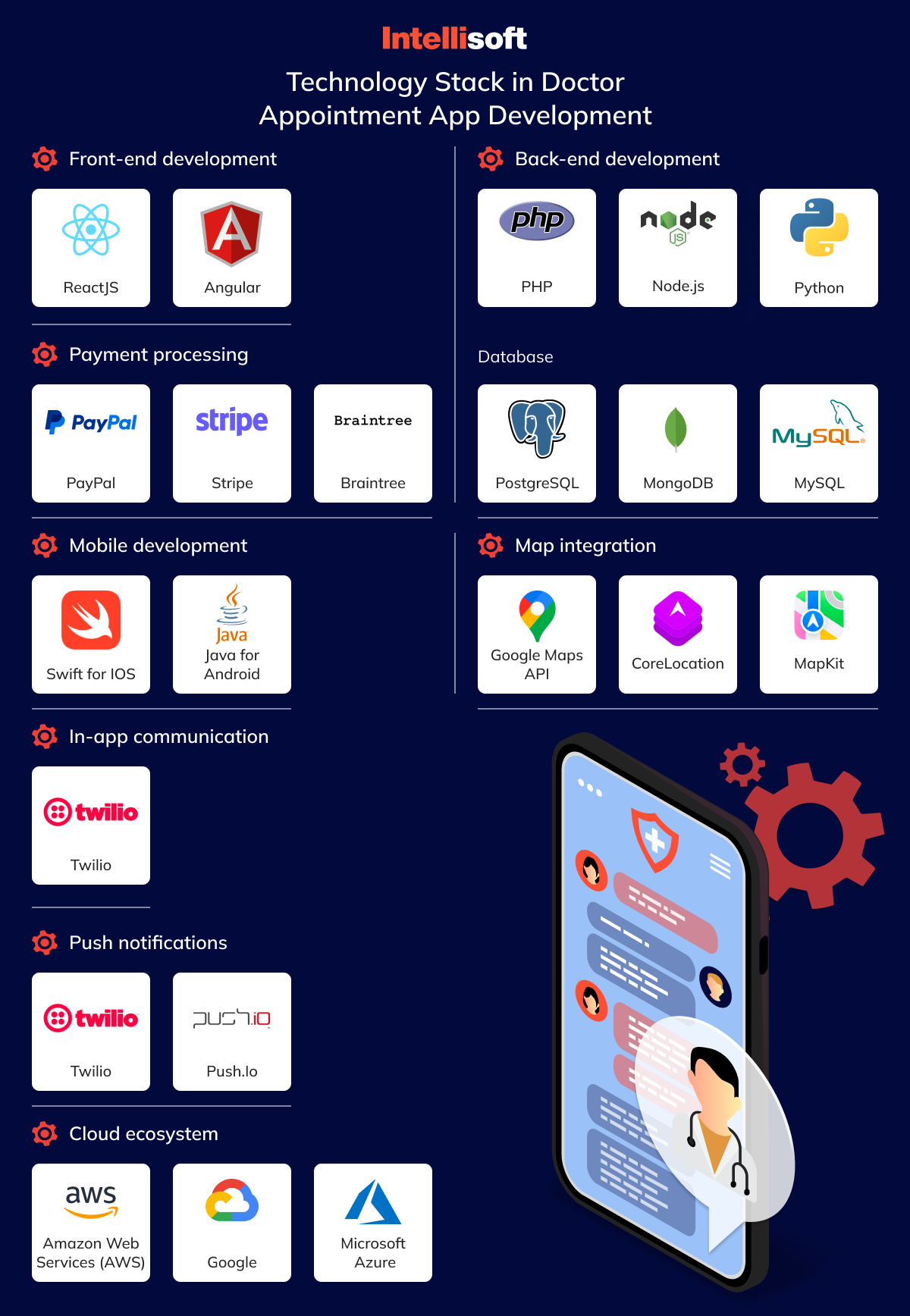
Sample Architecture of a Doctor Appointment Mobile App
Our software development experts suggest the following architecture for your doctors on demand app.
- Patient App. It interacts with GPS and payment gateways and connects to the cloud server for various services.
- GPS. This feature is integrated into the patient app to locate nearby doctors or clinics and provide navigation assistance.
- Payment Gateways. These services process financial transactions within the patient app, likely for payment of consultation fees.
- Cloud Server. This central node is the hub for various features, such as video streaming, messaging, data storage, and processing. These features are vital for teleconsultations and communication between patients and doctors. The node is also responsible for data storage and processing, crucial for managing appointment data, patient records, and other important information.
- Admin Web Panel. This interface is intended for administrators to oversee the app’s operations, manage appointments, and access analytics and reporting. It communicates directly with the Cloud server.
- Doctor App. This application enables doctors to manage appointments, view patient information, and engage in video consultations. It is integrated with a cloud server and directly linked to the EHR system.
- EHR (Electronic Health Records). This system electronically stores detailed patient health records and is linked to the doctor on demand app for easy access and updating of data.
- Laboratory Information System. This system manages laboratory test information and results, connecting to the Cloud server for seamless integration with the app’s workflow, including test ordering and result reception.
- Practice Management System. This system is designed to handle the administrative and financial aspects of operating a medical practice. It aids in scheduling appointments, managing billing, and monitoring patient flow. Besides, it is connected to a Cloud server, which indicates that it is part of the app’s integrated services.
The patient app serves as the primary point of entry for users. It allows them to search for doctors, schedule appointments, and make payments. The backbone of the Online Doctor Appointment System is the cloud server, which manages the core data and communications. The doctor app, electronic health record (EHR), laboratory information system, and practice management system are all connected to this central server, enabling a seamless flow of information across the different aspects of the healthcare service process.
Doctor Booking Appointment App Development Cost
Developing an essential doctor appointment app costs between $100,000 and $150,000. This foundational version includes both a web application and a cross-platform mobile application. It features essential functions such as specialist selection, appointment booking, and availability management. The back-end architecture is straightforward and doesn’t include integration with Electronic Health Records (EHR).
The required investment for a moderately complex solution falls between $150,000 and $250,000. This version provides a more comprehensive offering, including web and cross-platform mobile applications. It supports appointment scheduling, telehealth capabilities, medication and treatment management, and introductory data analytics. Moreover, it enables integration with EHR systems or other essential healthcare platforms, improving its usefulness.
The advanced doctors on demand app is available for investment starting at $250,000. This solution includes the development of complex web and cross-platform mobile applications equipped with a wide range of advanced features. The Online Doctor Appointment System provides telemedicine, AI-driven chatbots, patient engagement mechanisms such as gamification to encourage health goal achievement, and personalized user experiences enhanced with machine learning.
The software has a complex back-end structure and can integrate with smart devices, multiple EHR systems, and other medical software systems. Additionally, it offers predictive health analytics and tailored visit frequency monitoring, medication prescriptions, refills, and ordering.
It’s important to note that these costs do not include ongoing license fees associated with cloud services.

IntelliSoft’s Approach to the Doctor Appointment App Development
At IntelliSoft, we specialize in developing healthcare apps that are user-friendly, efficient, and secure. Our approach emphasizes user experience, data security, and interoperability. We do both custom solutions and existing software improvement.
Our client, Daintel, requested the latter to transform their MVP into a comprehensive medical information system, enhancing its performance and integrating critical ICU modules. This system now supports various functionalities, including prescription management, patient health monitoring, and data analytics across different healthcare departments.
Contact us today if you want a digital tool that improves healthcare delivery and overall patient experience.
